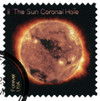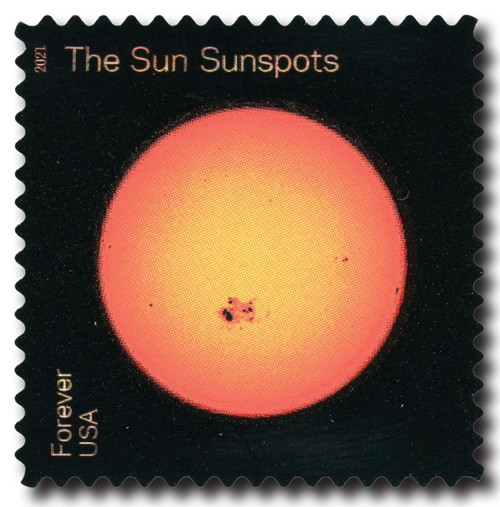
# 5607 - 2021 First-Class Forever Stamp - Sun Science: Coronal Hole
US #5607
2021 Coronal Hole – Sun Science
- Pictures a coronal hole on the sun
- One of 10 stamps in the Sun Science set
Stamp Category: Commemorative
Set: Sun Science
Value: 55¢ First Class Mail Rate (Forever)
First Day of Issue: June 18, 2021
First Day City: Greenbelt, Maryland
Quantity Issued: 18,000,000
Printed by: Banknote Corporation of America
Printing Method: Flexographic, Foil Stamping
Format: Panes of 20
Tagging: Phosphor, block tag
Why the stamp was issued: To showcase the powerful and mysterious science behind the functioning of our sun.
About the stamp design: Pictures a colorized images from NASA’s Solar Dynamics Observatory of a coronal hole on the sun. According to NASA, the color of this stamp represents an image of the sun as viewed with “extreme ultraviolet wavelength 193 Angstroms.”
First Day City: The First Day of Issue Ceremony was held at Greenbelt Main Post Office. It was originally to be held at the NASA Goddard Space Flight Center, but was moved due to observance of the Juneteenth Federal Holiday and the facility being closed.
About the Sun Science set: Includes 10 stamp designs picturing different details of our sun along with phenomena associated with it. Each design pictures a colorized image from NASA’s Solar Dynamics Observatory. The different colors represent a different wavelength that reveals or highlights a particular aspect of our sun.
History the stamp represents: The Sun’s corona is a bright outer layer of plasma that reaches hundreds of thousands of miles into space. Temperatures measure over 1.8 million degrees Fahrenheit in most areas, but there are some spots with lower temperatures. When viewed under ultraviolet or x-rays, these areas appear darker than the surrounding corona and are thus nicknamed “coronal holes.” (In actuality, coronal holes are still incredibly bright and cannot be distinguished under visible light.)
The Sun’s corona is constantly shifting and changing, which means so are coronal holes. All of this is influenced by the Sun’s magnetic fields. The first coronal holes were observed in the 1960s. They were viewed through x-ray imaging and also at radio wavelengths by the Sydney Chris Cross Radio Telescope. However, scientists still didn’t know what the phenomenon was.
In the 1970s, Skylab made history by using x-ray telescopes to shed some light on coronal holes. This provided much greater data on the structure of the Sun’s corona. Since then, scientists have found that the coronal holes move to different areas during different parts of the 11-year solar cycle. However, there is still much we don’t understand about the science of the Sun’s corona. This poses a fun challenge for scientists everywhere – and job security!
US #5607
2021 Coronal Hole – Sun Science
- Pictures a coronal hole on the sun
- One of 10 stamps in the Sun Science set
Stamp Category: Commemorative
Set: Sun Science
Value: 55¢ First Class Mail Rate (Forever)
First Day of Issue: June 18, 2021
First Day City: Greenbelt, Maryland
Quantity Issued: 18,000,000
Printed by: Banknote Corporation of America
Printing Method: Flexographic, Foil Stamping
Format: Panes of 20
Tagging: Phosphor, block tag
Why the stamp was issued: To showcase the powerful and mysterious science behind the functioning of our sun.
About the stamp design: Pictures a colorized images from NASA’s Solar Dynamics Observatory of a coronal hole on the sun. According to NASA, the color of this stamp represents an image of the sun as viewed with “extreme ultraviolet wavelength 193 Angstroms.”
First Day City: The First Day of Issue Ceremony was held at Greenbelt Main Post Office. It was originally to be held at the NASA Goddard Space Flight Center, but was moved due to observance of the Juneteenth Federal Holiday and the facility being closed.
About the Sun Science set: Includes 10 stamp designs picturing different details of our sun along with phenomena associated with it. Each design pictures a colorized image from NASA’s Solar Dynamics Observatory. The different colors represent a different wavelength that reveals or highlights a particular aspect of our sun.
History the stamp represents: The Sun’s corona is a bright outer layer of plasma that reaches hundreds of thousands of miles into space. Temperatures measure over 1.8 million degrees Fahrenheit in most areas, but there are some spots with lower temperatures. When viewed under ultraviolet or x-rays, these areas appear darker than the surrounding corona and are thus nicknamed “coronal holes.” (In actuality, coronal holes are still incredibly bright and cannot be distinguished under visible light.)
The Sun’s corona is constantly shifting and changing, which means so are coronal holes. All of this is influenced by the Sun’s magnetic fields. The first coronal holes were observed in the 1960s. They were viewed through x-ray imaging and also at radio wavelengths by the Sydney Chris Cross Radio Telescope. However, scientists still didn’t know what the phenomenon was.
In the 1970s, Skylab made history by using x-ray telescopes to shed some light on coronal holes. This provided much greater data on the structure of the Sun’s corona. Since then, scientists have found that the coronal holes move to different areas during different parts of the 11-year solar cycle. However, there is still much we don’t understand about the science of the Sun’s corona. This poses a fun challenge for scientists everywhere – and job security!













